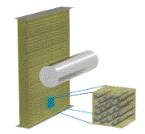Mechanical and Materials Engineering, Department of

Department of Engineering Mechanics: Dissertations, Theses, and Student Research
Date of this Version
Summer 7-26-2014
Document Type
Dissertation
Abstract
Blast induced neurotrauma (BINT) has been designated as the “signature injury” to warfighters in the recent military conflicts. In the past decade, conflicts in Iraq (operation Iraqi freedom) and Afghanistan (operation enduring freedom) as well as the increasing burden of the terrorism around the world resulted in an increased number of cases with blast Traumatic Brain Injury (bTBI). Recently, a lot of research has been done to study the neurological and neurochemical degenerations resulting from BINT using animal models especially rat models. However, it is not clear how and whether the biological outcomes from animal models can be translated to humans; this work is aimed to address this issue.
In this dissertation, the criteria for achieving a standardized methodology to produce shock blast waves are identified. Firstly, shock tube adjustable parameters (SAPs) such as breech length, type of gas and membrane thickness were used for controlling and producing desired blast waves by manipulating shock wave parameters (SWPs). Secondly, using a surrogate head model, the data from the laboratory experiments were compared with experimental data obtained from the field explosions data to show the validity of the laboratory experiments. Finally, effect of test section location on the fidelity of the rat model in simulating field conditions was studied. Through these steps a standardized and accurate method of replicating the field blast was established.
Using the standardized methodology to model blast waves, the intracranial pressure for various incident pressures on the rat model was studied. Furthermore, to understand the mechanisms of loading and to study the influence of field variables, a finite element model of rat along with the simple ellipsoidal model was developed. With these models, the variables that influence the intracranial pressure such as skull thickness, skull modulus, and skull shape and skull cross section area were studied. Finally, experimental data of intracranial pressure from rat and postmortem human specimen (PMHS) along with their corresponding numerical models were used to develop a model to predict the intracranial pressure. Finally, from this model it was predicted that for the same incident pressure human sustain a higher intracranial pressure than rats, which is contrary to the current scaling law developed to scale injury threshold across species, based on mass.
Adviser: Ruqiang Feng


Comments
A dissertation Presented to the Faculty of The Graduate College at the University of Nebraska In Partial Fulfillment of Requirements For the Degree of Doctor of Philosophy, Major: Mechanical Engineering and Applied Mechanics, Under the Supervision of Professor Ruqiang Feng. Lincoln, Nebraska: July, 2014
Copyright (c) 2014 Aravind Sundaramurthy